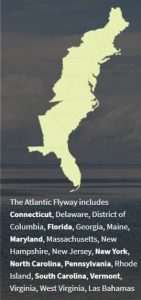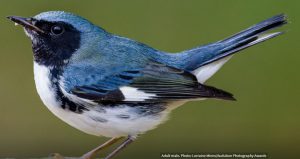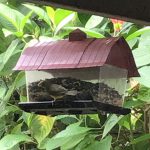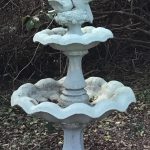Kudos to our Sea Grant Agent, Ana Zangroniz for creating a blog to celebrate our 2nd National Wildlife Day on September 4th this year. And yes the Fall Migratory Season of the Atlantic Flyway is happening now!
At our Extension Office we have already spotted hummingbirds from afar, Blue-Gray Gnatcatchers everywhere flittering after insects, and Wood Thrushes. And we are seeing swallows diving for insects that are exposed in newly plowed fields in the Redland. At home for Labor Day I spotted a ruby throated humming bird directly above my head. Laura Vasquez, Urban Horticultural Extension Agent in charge of our team wants photos. This means I would need to carry my cell phone everywhere at all times to catch photos. This is not always possible if one is digging in my home landscape or working in our shadehouse.
If you know the name of the bird you have spotted you can find information and photos on Audubon’s Field Guide website. For example we should soon see Black Throated Blue Warblers Black-throated Blue Warbler | Audubon Field Guide.
It takes practice, skill with a camera, patience and listening for unusual calls to spot birds. This can lead to a lifetime fascination and I admit I am only a novice. No Worries. I can still see lots of birds and learn as I go and so can you!
It should not be a surprise to find that butterfly and native plant enthusiasts are also bird lovers.. It is the inexplicable lure of nature that draws us all. And yes, it starts with the plants, native plants and getting them in the right place in your landscape. Right Plant, Right Place! There is still some time left in our rainy season to get these plants for birds growing. Don’t forget you can use the captured rain water in your full rain barrels to keep them growing.
While many birds can be enticed to a safely located bird feeder, there are many more that will flock to feast on berries growing on our native plants and insects as well. First, what is a safe location for bird feeders? Well out of jumping range of free roaming cats and protected by an overhang or tree limbs from predatory birds aka hawks, osprey, eagles, swallow tailed kites which are also arriving here for winter. Trees are very important for birds in our developed urban areas as are thick shrubs. Multilayered landscapes create the best habitats for all wildlife. Think about where butterflies roost at night and when it rains and where do moths hangout during the day? Without cover all birds are, well, sitting ducks out in the open.
Gardening Hacks for the Birds
Feeders: A mix of grains and sunflower seeds will attract the widest range of birds to your feeder. However many migrating birds prefer the smaller grains. I keep a feeder with grains only and another with sunflowers seeds only. I subscribe to the thought that you can never have too many bird feeders ( or books on birds, bird i.d. guides etc.). I have actually observed cardinals looking into my window and chirping at me when the feeder is empty.
Do not forget sources of water. All life needs clean water to survive. I sourced a hanging water container for the birds since ground level bird baths in my yard are not protected from the neighborhood stray cats. And empty and replace water every 3-days if there is no rain.
Below is a list of native plants and migratory birds noted by common names. Use the links provided to learn more.
Berries & Fruit for Birds: beauty berry, Barbados cherry, wild coffee, gumbo limbo, Bahama strongback, dahoon holly, white ironwood, satinleaf, lancewood, bird pepper, lignum vitae, stoppers, red mulberry, wild sage, wax myrtle, firebush, Florida privet, cinnamon bark and butterfly sage. And insect eating birds will come to feed on the many insects these pollinator happy plants will also entice. Oak trees are miracle trees for nectar when they flower and humming birds collect pollen from them. Warblers love the insects they find in oak trees, a major canopy tree full of life if you have the space. All information on these natives can be found here :The Institute for Regional Conservation
Migratory birds you should see in a Florida-Friendly Landscape ( home, school ground, park) during fall and spring migratory seasons: Painted Bunting, Indigo Bunting, Black and White Warbler, Blue-Gray Gnatcatcher, Catbird, Downy Wood Pecker, Loggerhead Shrike, Palm Warbler, Brown Thrasher, Mangrove Cuckoo, Mourning Dove, White Crowned Pigeon, Scissor-tailed Kites, Ruby Throated Hummingbird, Rufous Hummingbird, American Redstart, Chuck-Wills Widow, Common Nighthawk, and Cedar Waxwings Information and photos can be found here Guide to North American Birds | Audubon
This is a start to entice you, and get you watching. Even more birds can be spotted in our forest and coastal natural areas. Plant back some of these native plants to re-create lost habitat and enjoy the show!
Happy Gardening, Happy Hiking!
Could a birding boom in the U.S. help conservation take flight?
Feeding Birds Could Get Pricey this Year.
A Bird’s-Eye View: How Birds Select Habitat
Attracting Backyard Birds: Bird Feeder Selection
Helping Cavity-Nesters in Florida
 1
1


